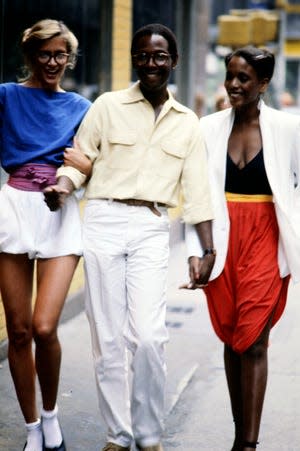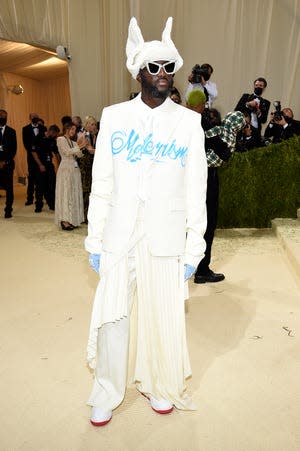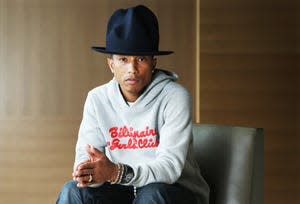Insider Presents the 'Black Ensemble' of pioneers, models, designers, and thought leaders of luxury fashion
Fashion for the Culture
An exploration of Black influence, excellence, and acceptance in high fashion
In a 2013 interview with British Vogue, Stella Jean, a Haitian-Italian designer, activist, and a protégé to Giorgio Armani, had a message: "Fashion can be used as a cultural translator and a tool against colonization; it re-establishes the balance between symbols, stories, and different worlds through style." Years later at the height of the Black Lives Matter protests in the summer of 2020, this message gained new poignancy for fashion leaders.
For centuries, high fashion and haute couture have been shaped by Eurocentric beauty standards. But Black influence has been ever present if rarely acknowledged. From early pioneers whose work helped define the style and ethos of their time to today’s trendsetters who set the standard for cool, Black artists, creators, influencers, and luminaries in the highest echelons of fashion deserve their flowers. This section of Black Ensemble: Fashion for the Culture looks back on the pioneers, models, designers, and thought leaders who form the foundation of luxury fashion today.
pioneers
Josephine Baker
Josephine Baker used her style and influence to not only shock and entertain audiences but to challenge racial structures. The Parisian clubs and art houses she called home were some of the earliest outlets for Black American entertainers to build their careers, in contrast to the unwelcoming atmosphere in the US during Prohibition. Known for glam, bold, feminine silhouettes, sequins, and feathers, her costumes cemented the dress code of the Jazz Age.




Zelda Wynn Valdes
Though she was also a product of the Jazz Age, Zelda Wynn Valdes provided the source code for couture fashion throughout the civil-rights era. After opening the first Black-woman-owned design studio on Broadway in New York City, her designs were worn by the likes of Josephine Baker, Joyce Bryant, Ella Fitzgerald, Eartha Kitt, Diahann Carroll, Aretha Franklin, Gladys Knight, and many more. Her trademark plunging necklines, cinched waistlines, and accentuated curves brought a distinctly feminine yet powerful mystique to Black entertainers and eventually crossed the racial divide. In an era when the industry was deeply segregated, Hugh Hefner commissioned her to design the original Playboy bunny outfit, a culturally defining silhouette that endures to this day.



Cicely Tyson
Scouted as a model at 30 years old, Cicely Tyson was a beacon of chic at every stage of her multifaceted career. Within a year of attending the world’s first modeling school for African Americans in New York City, she graced the pages of Ebony, Jet, and Vogue, and though she quickly moved from modeling to acting, she was firmly cemented as a trendsetter. A champion of natural hair, bold patterns, and a fearless use of textures and fur, Tyson often stole the spotlight wherever she went. Her long career gave the world a primer on Black excellence in film, all while looking impeccable onstage and off.



Dapper Dan
Did Dapper Dan bring high fashion to street fashion, or was it the other way around? His often adversarial relationships with Gucci, Louis Vuitton, and other luxury brands throughout the 1980s and ’90s focused attention on the power struggle between cultural expression and brand sovereignty in the industry. Many of his first clients were gamblers and drug dealers in Harlem at the height of the crack epidemic, and Dan was routinely rejected by the mainstream fashion world. So he did what many Black creators were doing at the time: He created his own market and made up his own rules. His bold use of luxury-brand labels in his own designs mirrored the social rebellion that defined early hip-hop, giving rise to the styles of rap icons like LL Cool J, Salt-N-Pepa, Jam Master Jay, and more.



models
Donyale Luna
Donyale Luna, one of the first Black supermodels, lived a life of contradictions. After her 1966 cover of British Vogue, world-class photographers such as David McCabe and Andy Warhol clamored to work with her in the US and Europe, and she was often paid hundreds of dollars an hour (thousands in today’s money). Yet she was squeezed into a racialized box like many lighter-skinned people of color as the civil-rights movement raged. She bore the dehumanizing trope of the “exotic model” on set, often the only way she could exist in a world that did not know how to appreciate Black beauty without fetishizing or animalizing it. At 6-foot-2, her willowy frame, wide almond eyes, and sharp features stopped people in their tracks and inspired Adel Rootstein to model a mannequin on her likeness, which inspired the same standard display mannequin used in stores today.



Tracey “Africa” Norman
Tracey “Africa” Norman was the first Black trans model to reach international fame. At a time when most Black trans people were struggling to pass in everyday society, she was excelling in her field, booking shoots with Essence, Vogue Italia, and Harper’s Bazaar with lightning speed after wandering uninvited into a model casting. Though she never reached the same level of fame as current Black trans celebrities like Laverne Cox, Isis King, and Leyna Bloom, her career was a gateway for the growing diversity in media today.


Grace Jones
Grace Jones, a theater performer turned model turned rock star walked through walls in every creative endeavor she tried. A champion of gender fluidity and early-’80s New Wave culture, her personal style combined African and West Indian patterns and textures with otherworldly silhouettes, providing a stark contrast to her flawless dark skin and deep-set eyes. Jones’ onstage style is associated with the birth of Afro-futurism, a distinctly inventive style that allows creators to experiment with the avant-garde and reach beyond traditional Western and European cuts.




Winnie Harlow
Tyra Banks discovered Winnie Harlow on Instagram as she was scouting for the 21st season of “America’s Next Top Model,” showing how powerful a tool for change social media can be in the often closed loop of high fashion. Harlow, who has vitiligo, did not win the top prize, but her appearance on the show was a historical moment that broke the seal for models with skin conditions and helped usher in a new desire for inclusivity from the world’s premier luxury brands. She has since walked for major brands like Fendi, Marc Jacobs, and Steve Madden, and has been featured in legacy fashion publications including Vogue Italia.




designers
Anne Lowe
Often referred to as the “Dean of American Designers,” Ann Lowe is the unsung hero behind many of American high society’s looks in the 1940s and ’50s. Famously selective about her clients, she designed exclusively for the American elite, including the Roosevelt and Rockefeller families, and she worked on commission for the premier boutiques of the time. After her studio in Harlem flooded, she designed Jacqueline Kennedy's iconic 1953 wedding dress in just 10 days before the wedding. But because of her race, she rarely received public credit for her work and was often pressured to charge much less than her intricate designs were worth. Her technique, extravagance, and attention to detail have set the standard for generations of modern bridalwear.



Jay Jaxon
Jay Jaxon was not only the first Black American to become a French couturier but the first American ever. Shortly after moving to Paris in the late 1960s, he designed for Yves Saint Laurent, Christian Dior, and Jean-Louis Scherrer. His mastery of the skills needed to make a couture garment from scratch was rare, and his ability to adapt to the aesthetic of any brand earned him respect at every fashion house he worked with. For most designers, the French maisons are the pinnacle of a career in high fashion. In the way of a true creative, Jaxon followed his inspiration back to the US in the 1980s and continued to make costumes for TV studios, theaters, and custom outfits for celebrities such as Annie Lennox and Thelma Houston in Los Angeles.



Willi Smith
Known as the father of streetwear, Willi Smith intentionally avoided the elitist ethos of luxury fashion. By bringing a chic attitude to sportswear and aiming to serve everyday people in urban environments, he helped define streetwear and cemented its place in the industry. Taking great pains to ensure his clothes were sold at an affordable price, he founded his label, WilliWear Ltd., in 1974, and took pains to ensure his clothing was affordable even as he sourced high-quality, natural fabrics from places like India. Smith was one of the first designers to commercialize gender-neutral clothing, paving the way for the new generation of disruptive streetwear brands like Off-White, Telfar, and Pyer Moss.



Virgil Abloh
Virgil Abloh not only disrupted luxury fashion, he pushed boundaries in many other design disciplines as well. Formally trained as an architect, he dabbled in interior design, graphic design, classical art, and furniture design, all of which influenced his approach to clothing. In 2018, he became the first Black artistic director of menswear at Louis Vuitton and was quickly recognized as one of the most influential designers of his generation. His sculptural and illustrative approach, combined with the social commentary literally written on his designs, give his clothes the air of performance art. Through his Off-White label and many other brand partnerships, Abloh has helped bridge the divide between luxury and streetwear, often making them indistinguishable.



thought leaders
André Leon Talley
As the first Black creative director of American Vogue, André Leon Talley loomed large as the preeminent fashion journalist and tastemaker. Spanning decades since the ‘70s, Talley served as a thoughtful narrator of the most exciting moments in fashion and promoted diversity in the industry through top publications including Women’s Wear Daily, W, Ebony, The New York Times, and Interview magazine at Andy Warhol’s Factory. Often donning dramatic robes, caftans, capes, and furs that on anyone else would seem out of date or gauche, on his imposing 6’6 frame he evoked an imperial air and reveled in making grand entrances. And much like a wise king of old, he would advise celebrities, politicians, designers, and more who sought his counsel on all matters of style.




Telfar Clemens
Telfar Clemens is flipping the business model and culture of exclusivity in luxury fashion with his eponymous brand. His vegan-leather Shopping Bag and unisex collections are released in preplanned drops rather than mass produced, democratizing luxury sportswear in a way that defies the appropriation and copying of original designs that's so common in the fashion industry. Though his clothes and accessories almost always sell out within minutes, the price-by-demand structure embedded in his sales process has proven to drive more accessibility and more interest in the egalitarian philosophy behind the brand: “It’s not for you – it’s for everyone.”



Zendaya
Zendaya is young, but her methodical yet daring approach to fashion has raised her social currency to that of a seasoned veteran. Not afraid to take risks, she regularly sets trends through bold experimentations with color and wholeheartedly embraces different silhouettes, from classic chic to the avant-garde. With the help of the stylist Law Roach, she routinely pays homage to the groundbreaking models and fashion icons that came before her. Her red-carpet looks are careful, studied, always elegant, and emblematic of Gen Z’s evolving relationship with high fashion.



Pharrell Williams
Pharrell Williams has long since reached legendary status as a musician and artist, but his recent appointment as the new creative director for menswear at Louis Vuitton has put him on the edge of something new. Though he’s not a designer by training, Williams has been innovating and setting streetwear trends since the early 2000s with the Billionaire Boys Club brand, partnering with designers to make sustainable fabrics, luxury accessories, and sneakers. His position is a testament to the legacy of Virgil Abloh and folds neatly into this new wave of mindful representation from the great fashion institutions. He joins the ranks of Olivier Rousteing, the creative director of Balmain; Ozwald Boateng, a former designer for Givenchy menswear; and Edward Enninful, the editor in chief of British Vogue. His new LV collection debuted at Paris Men's Fashion Week in June.



Black creatives today have a rich legacy to protect and nurture as the fashion world evolves. We’ve barely scratched the surface here of unsung fashion heroes who deserve credit from the multibillion-dollar luxury brands that benefited from their early work. As you explore this series, you’ll find more forward-looking features honoring the Black designers, stylists, and tastemakers currently driving the industry to new heights. We also dive into current stories of triumph in mainstream fashion, where Black people are leading the charge in size inclusivity and challenging the tradition of cultural appropriation in commercialized fashion. Click below to find more Black Ensemble features.
More in the series:
Credits
Reporting: Ashley Davis
Editing: Stephanie Hallett
Copy editing: Jonann Brady
Series editing: Brea Cubit, Stephanie Hallett
Design, development, and graphics: Taylor Tyson
Design editing: Kazi Awal, Jenny Chang-Rodriguez
Photo curation: Crystal Cox, Isabel Fernandez-Pujol
Photography: Josephine Baker Hulton Archive/Getty Images, General Photographic Agency/Getty Images, Gaston Paris/Roger Viollet via Getty Images, Keystone-France/Gamma-Keystone via Getty Images; Zelda Wynn Valdes Carl Van Vechten Collection/Getty Images, Bettmann / Getty Images, George Freston/Fox Photos/Getty Images; Cicely Tyson AP, Michael Ochs Archives/Getty Images, Dennis Oulds/Central Press/Getty Images; Dapper Dan Ezio Petersen/Getty Images, Nicholas Hunt/Getty Images for Tiffany & Co., Mark Sagliocco/Getty Images for Manhattan Magazine; Donyale Luna RDB/ullstein bild via Getty Images, Patrice Habans/Paris Match via Getty Images, Jack Garofalo/Paris Match via Getty Images; Tracey Africa Norman Business Wire, Dimitrios Kambouris/Getty Images for GLAAD; Grace Jones Anthony Barboza/Getty Images, Chris Walter/WireImage, John Kisch Archive/Getty Images, Dave Hogan/Hulton Archive/Getty Images; Winnie Harlow DANI POZO/AFP via Getty Images, Dave Benett/Getty Images, Kelly Taub/WWD/Penske Media via Getty Images, Arturo Holmes/Getty Images; Anne Lowe Bachrach/Getty Images, Ted Fitzgerald/MediaNews Group/Boston Herald via Getty Images, Bettmann Archive/Getty Images; Jay Jaxon Bequest of Lloyd Hardy, Rachel Fenderson Collection, Bequest of Lloyd Hardy, Rachel Fenderson Collection, NBCU Photo Bank; Willi Smith Thomas Iannaccone/WWD/Penske Media via Getty Images, Anthony Barboza/Getty Images, John Bright/Penske Media via Getty Images; Virgil Abloh Evan Agostini/Invision/AP, AP Photo/Ted Shaffrey, AP Photo/Thibault Camus; André Leon Talley John Lamparski/Getty Images, Taylor Hill/Getty Images, Craig Barritt/Getty Images, Jemal Countess/Getty Images; Telfar Clemens Jamie Squire/Getty Images, Arturo Holmes/Getty Images, Mireya Acierto/Getty Images; Zendaya Edward Berthelot/Getty Images, Karwai Tang/WireImage, James Devaney/GC Images; Pharrell Williams Anthony Reginato/Newspix/Getty Images, Victor VIRGILE/Gamma-Rapho via Getty Images, Evan Agostini/Getty Images
Read the original article on Business Insider